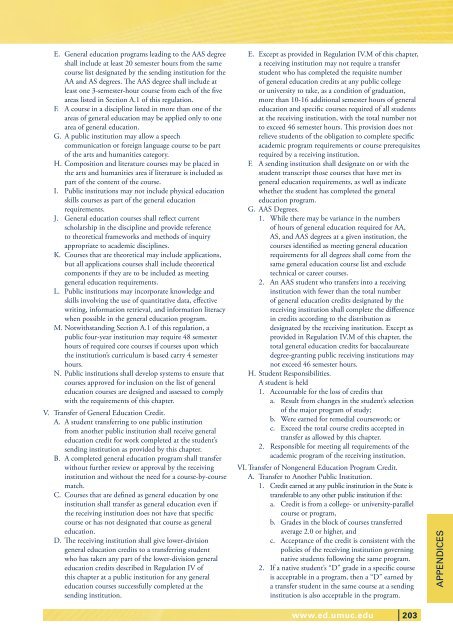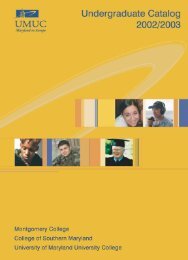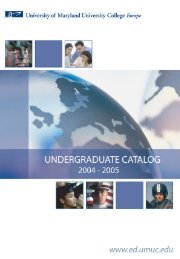UNDERGRADUATE CATALOG - UMUC Europe
UNDERGRADUATE CATALOG - UMUC Europe
UNDERGRADUATE CATALOG - UMUC Europe
Create successful ePaper yourself
Turn your PDF publications into a flip-book with our unique Google optimized e-Paper software.
E. General education programs leading to the AAS degree<br />
shall include at least 20 semester hours from the same<br />
course list designated by the sending institution for the<br />
AA and AS degrees. The AAS degree shall include at<br />
least one 3-semester-hour course from each of the five<br />
areas listed in Section A.1 of this regulation.<br />
F. A course in a discipline listed in more than one of the<br />
areas of general education may be applied only to one<br />
area of general education.<br />
G. A public institution may allow a speech<br />
communication or foreign language course to be part<br />
of the arts and humanities category.<br />
H. Composition and literature courses may be placed in<br />
the arts and humanities area if literature is included as<br />
part of the content of the course.<br />
I. Public institutions may not include physical education<br />
skills courses as part of the general education<br />
requirements.<br />
J. General education courses shall reflect current<br />
scholarship in the discipline and provide reference<br />
to theoretical frameworks and methods of inquiry<br />
appropriate to academic disciplines.<br />
K. Courses that are theoretical may include applications,<br />
but all applications courses shall include theoretical<br />
components if they are to be included as meeting<br />
general education requirements.<br />
L. Public institutions may incorporate knowledge and<br />
skills involving the use of quantitative data, effective<br />
writing, information retrieval, and information literacy<br />
when possible in the general education program.<br />
M. Notwithstanding Section A.1 of this regulation, a<br />
public four-year institution may require 48 semester<br />
hours of required core courses if courses upon which<br />
the institution’s curriculum is based carry 4 semester<br />
hours.<br />
N. Public institutions shall develop systems to ensure that<br />
courses approved for inclusion on the list of general<br />
education courses are designed and assessed to comply<br />
with the requirements of this chapter.<br />
V. Transfer of General Education Credit.<br />
A. A student transferring to one public institution<br />
from another public institution shall receive general<br />
education credit for work completed at the student’s<br />
sending institution as provided by this chapter.<br />
B. A completed general education program shall transfer<br />
without further review or approval by the receiving<br />
institution and without the need for a course-by-course<br />
match.<br />
C. Courses that are defined as general education by one<br />
institution shall transfer as general education even if<br />
the receiving institution does not have that specific<br />
course or has not designated that course as general<br />
education.<br />
D. The receiving institution shall give lower-division<br />
general education credits to a transferring student<br />
who has taken any part of the lower-division general<br />
education credits described in Regulation IV of<br />
this chapter at a public institution for any general<br />
education courses successfully completed at the<br />
sending institution.<br />
E. Except as provided in Regulation IV.M of this chapter,<br />
a receiving institution may not require a transfer<br />
student who has completed the requisite number<br />
of general education credits at any public college<br />
or university to take, as a condition of graduation,<br />
more than 10-16 additional semester hours of general<br />
education and specific courses required of all students<br />
at the receiving institution, with the total number not<br />
to exceed 46 semester hours. This provision does not<br />
relieve students of the obligation to complete specific<br />
academic program requirements or course prerequisites<br />
required by a receiving institution.<br />
F. A sending institution shall designate on or with the<br />
student transcript those courses that have met its<br />
general education requirements, as well as indicate<br />
whether the student has completed the general<br />
education program.<br />
G. AAS Degrees.<br />
1. While there may be variance in the numbers<br />
of hours of general education required for AA,<br />
AS, and AAS degrees at a given institution, the<br />
courses identified as meeting general education<br />
requirements for all degrees shall come from the<br />
same general education course list and exclude<br />
technical or career courses.<br />
2. An AAS student who transfers into a receiving<br />
institution with fewer than the total number<br />
of general education credits designated by the<br />
receiving institution shall complete the difference<br />
in credits according to the distribution as<br />
designated by the receiving institution. Except as<br />
provided in Regulation IV.M of this chapter, the<br />
total general education credits for baccalaureate<br />
degree-granting public receiving institutions may<br />
not exceed 46 semester hours.<br />
H. Student Responsibilities.<br />
A student is held<br />
1. Accountable for the loss of credits that<br />
a. Result from changes in the student’s selection<br />
of the major program of study;<br />
b. Were earned for remedial coursework; or<br />
c. Exceed the total course credits accepted in<br />
transfer as allowed by this chapter.<br />
2. Responsible for meeting all requirements of the<br />
academic program of the receiving institution.<br />
VI. Transfer of Nongeneral Education Program Credit.<br />
A. Transfer to Another Public Institution.<br />
1. Credit earned at any public institution in the State is<br />
transferable to any other public institution if the:<br />
a. Credit is from a college- or university-parallel<br />
course or program,<br />
b. Grades in the block of courses transferred<br />
average 2.0 or higher, and<br />
c. Acceptance of the credit is consistent with the<br />
policies of the receiving institution governing<br />
native students following the same program.<br />
2. If a native student’s “D” grade in a specific course<br />
is acceptable in a program, then a “D” earned by<br />
a transfer student in the same course at a sending<br />
institution is also acceptable in the program.<br />
www.ed.umuc.edu 203<br />
APPEndiCEs






